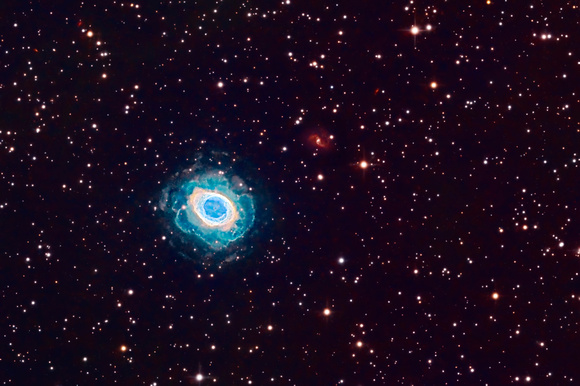Onion RIngs - M57 in SHO
Planewave CDK12.5; AP 1100GTO AE
ASI6200MM, - Antlia Pro Broadband and 3.5nm Ha filters
SHO: (34,41,34 x 420s, Bin 1, Gain 200) (representing appox 50% of total frames taken)
Total integration time = 12.7 hrs (Apr 16,17,18,19,21 2024)
M57 is a popular target in both narrowband and broadband imaging, due to it brightness and colourful emissions. In RGB broadband, it appears as and of red and white, with a dimmer central blue core. This ring of red and white is the brightest part of the PN, and the source of it’s common name – the Ring Nebula.
When imaged in narrowband, however, the complex shape of this planetary nebula becomes evident. The bright ring takes on the more complex shape of a helix or spiral that we are looking down the barrel of from our perspective. Its colour appears white (strong S,H and O signals nearer the nebulas centre), but a mixture of yellow (H) and red (S) dominated signals as the O signal declines.
From a narrowband perspection, a more appropriate name for the PN might have been the “Onion” Nebula, as two additional layers become evident with sufficient integration time. Outside of the ring, a florette patterned layer of blue O signal forms another layer of this onion, followed by a patchwork of yellow/green/red strong H, and to a lesser extent, S signal furtherest out. Notably, this outermost onion layer forms an almost perfect circle, suggesting that it may be spherical in nature, in stark contrast to the ring/helical spiral.
Thank goodness that our intuitive belief that exploding stars should generally result in a spherically symmetric patterns remains intact. At the same time, spins, asymmetrical material and radiation distributions, magnetic moments, and prevailing winds can make planetary nebulae take on a wide variety of forms.
For some reason (red shift?), the nearby galaxy IC 1296, along with even fainter galaxies, appeared strongest in S signal and thus red in the image. The star colours, on the other hand, were obtained through a combination of narrowband signals to mimic broadband colours and forced calibration to the true stellar spectra.
Almost 50% of the total frames taken were culled due to mixed sky conditions and my desire to use only the best frames to emphasize all of the dim layers of this onion.


